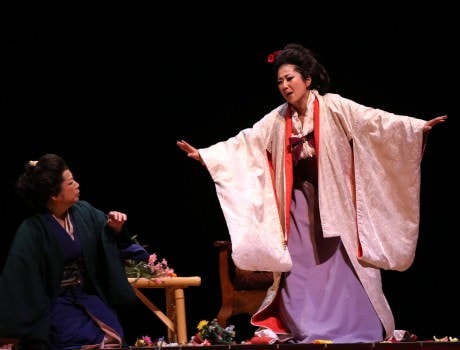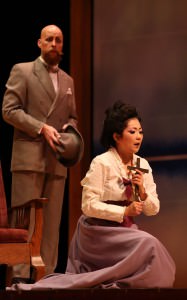The opera great Beverly Sills, who shared a birthday with me – and, sometimes, the same hair color, was saddened when she learned I had never attended an indoor opera.

That I’d been to several “Summer Opera in the Parks” productions did not assuage her.
This was the mid-1980s. I was still a kid. We were both members of a committee planning a massive fashion industry gala at the downtown Puck Building in support of the now defunct New York City Opera. Its New Jersey costume warehouse had been destroyed in a fire. Nearly every name fashion designer was involved in the benefit.
The gala’s proceeds were earmarked for costuming several upcoming operas.
Then, and for a long time afterwards, the lovely, legendary lady made a point of sending me a pair of tickets to each production at Lincoln Center.
Beverly would have loved The Lyric’s production of Puccini’s Madama Butterfly, performed in Italian with subtitles. I felt her presence when the audience arose as one for a thunderous standing ovation at the opera’s conclusion – a stunning surprise ending.
The attentive audience in the nearly full house was beautifully diverse – all ages and races, garbed in everything from tuxedos, evening gowns and stiletto Louboutins to jeans, flannel plaids, cowboy boots and crocs.
Madama Butterfly, which had its premiere in 1904, is a classic, one of the best-loved operas and considered the seventh most performed opera worldwide.
This near-perfect performance, directed by James Harp at The Lyric is a must-see. You will be alternately euphoric in the first act and crushed by the impending tragedy in the second.
And, you will want to go back for more.
The Baltimore Symphony, conducted by Steven White elicited a rapturous response from the audience. Two-thirds of the way through the opera, the BSO performed unimpeded by human voices or actors for nearly ten minutes. It was heaven.
So, too, was the Lyric Opera Chorus in several appearances onstage.
The story
In the late 19th century, a young U.S. Naval officer, Lt. Benjamin Franklin Pinkerton, aboard the vessel, the Abraham Lincoln, rents a house high on a Nagasaki hilltop from Goro (Philippe Pierce), a marriage broker. The house comes with three servants and a geisha wife, Cio-Cio-San, also known as Butterfly.
Pinkerton’s caddish behavior, accurately captured by Tenor Chad Shelton, is personified by the casual manner in which he wears his dress white officer’s uniform with the collar unbuttoned and spread apart.
Just as casual is Pinkerton’s approach to the contract for the house and the marriage, the terms which he controls. The contract is for 999 years, which he and only he can continue or terminate at the end of each month. Wealthy, handsome and outgoing, Pinkerton does not plan to stay long. His goal is to eventually marry a “real” wife, an American woman.
This is just a here and now thing.
Cavalier, Pinkerton is clueless about the depth of Cio-Cio-San’s feelings almost until the very end.
Cio-Cio-San is only 15 years old, but aged by a childhood that has seen her noble family plunged into poverty. Her father killed himself with a sword that Cio-Cio-San owns and cherishes among her handful of earthly belongings. She’s been reduced to working as a geisha, entertaining male visitors to the house.
She falls immediately, deeply in love with Pinkerton.
Where Pinkerton’s passion is a passing fancy, Cio-Cio-San is trusting.
“You think your marriage is a joke,” the American consul warns Pinkerton.
“But believe me, she’s serious.”
During the first act, Cio-Cio-San confides to Pinkerton that she’s secretly converted from Buddhism to Christianity. She hopes her Uncle, the Bonze, a Buddhist monk, doesn’t discover what she’s done. When he does, she is cast out from the family.
“I bow to Mr. Pinkerton’s god. It is my destiny,” she sings. “… I pray to the same God.”
She hopes Pinkerton will take her to his homeland – America.
Japanese native, Soprano Asako Tamura is Butterfly. Her voice was as clear, crystalline pure as a mountain stream. Like a flight of butterflies, every note soared out over the audience. When she was wounded, the audience felt her pain through her voice and her expressive emotions.
It is wrenching when she sings that she prefers “to die with honor when one can no longer live with honor.”
The entire cast was exquisite – even the goofballs portraying Pinkerton’s fellow officers who arrive at the wedding ceremony drunk and barely able to walk.
One of the most impressive cast members was 3-year old Liam O’Croinin, who, in a non-singing and non-speaking role, portrays the blue-eyed blonde child produced by Cio-Cio-San and Pinkerton’s brief union. The tot is impressive. Onstage for most of the second act, Liam behaves, hits his cues – and doesn’t act like a typical preschooler. He’s amazing.
Another Japanese native, mezzo soprano Mika Shigematsu, is Suzuki, listed as Butterfly’s maid. She is more than a maid, as portrayed by Shigematsu. She is the young woman’s confidant, advisor, best friend, protector – and surrogate mother.
Often stoically silent, Shigematsu’s facial expressions telegraphed her character’s emotions to the back of the Lyric’s massive balcony. When she sang, it was with a rich-voiced tinged with sadness and heartbreak for Cio-Cio-San’s painful predicament.

Sharpless, the American consul caught between Pinkerton’s heartless behavior and Cio-Cio-San’s heartrending love for the Naval officer which blinds her to reality of her situation, is given a bravura performance by baritone Timothy Mix,. Like Suzuki, his character is visibly pained by what has been wrought by Pinkerton’s careless, indifferent behavior.
Smaller roles are handled by the larger than life cast of Jason Buckwalter (The Registrar); Jimi James (The Bonze, Butterfly’s angry Buddhist monk Uncle); Jonathan Lasch, first seen as the Imperial Commissioner, returning in a second role as Yamadori, a rich wastrel of a nobleman courting Cio-Cio-San – with an even larger indifference to the wives in his life than Pinkerton; and Gabrielle DeMers in the thankless role of Kate Pinkerton, Pinkerton’s American wife.
John Conklin designed the production, a terrific, imaginative job.
Reminiscent of Japanese rice paper panels, three large, tall multi-paneled screens form the sides and rear of the set. Vertical panels in each screen noiselessly slide back and forth to allow entry to a cast member, change a scene, or to open behind a character revealing a silent vision – another character.
Early on, a screen slides open for a flashback: the suicide of Cio-Cio-San’s father. During a scene where Pinkerton talks about marriage, a screen slides away for a quick view of Kate Middleton, in full Gibson girl garb – foreshadowing his ultimate plans.
In Act II, when it is announced that Pinkerton has returned to Nagasaki, the screens part, showing Pinkerton in his dress whites, wearing the oversized, red-faced mask of a demon.
In the second act, a simple wood frame is lowered to indicate the window from which the naive Cio-Cio-San nightly has watched the Nagasaki harbor for three years, eagerly awaiting Pinkerton’s return.
She sits there stolidly on the final night, accompanied by the sleeping Suzuki and child, slowly crushed by despair.
Changes in lighting and mood are achieved by subtle projections upon the paneled rice paper screens. Kudos to noted, international opera lighting designer Donald Edmund Thomas.
When Cio-Cio-San and Suzuki joyously strew the stage with flower petals in anticipation of Pinkerton’s return, the lighting warms – you can almost smell the flowers.
Running Time: Two hours and 45 minutes, with one 20-minute intermission.
Madama Butterfly plays one more performance tomorrow, November 9, 2014, at 3 PM at The Modell Performing Arts Center at the Lyric -140 West Mount Royal Avenue, in Baltimore, MD. For tickets, call (410) 900-1150, or purchase them online.






Why the change to the ending with Pinkerton being stabbed??